Abstract
This paper reviews the mechanisms of anaphylactic shock in terms of the immunoglobulin and non-immunoglobulin triggering events, and the cellular events based on the rise in intracellular cyclic AMP and calcium that release preformed granule-associated mediators and the rapidly formed, newly synthesized mediators predominantly based on arachidonic acid metabolism. These primary mediators recruit other cells with the release of secondary mediators that either potentiate or ultimately curtail the anaphylactic reaction. The roles of these mediators in the various causes of cardiovascular collapse are examined. The treatment of anaphylactic shock involves oxygen, adrenaline and fluids. The importance and safety of intravenous adrenaline are discussed. Combined H1 and H2 blocking antihistamines and steroids have a limited role. Glucagon and other adrenergic drugs are occasionally used, and several new experimental drugs are being developed.
Full text
PDF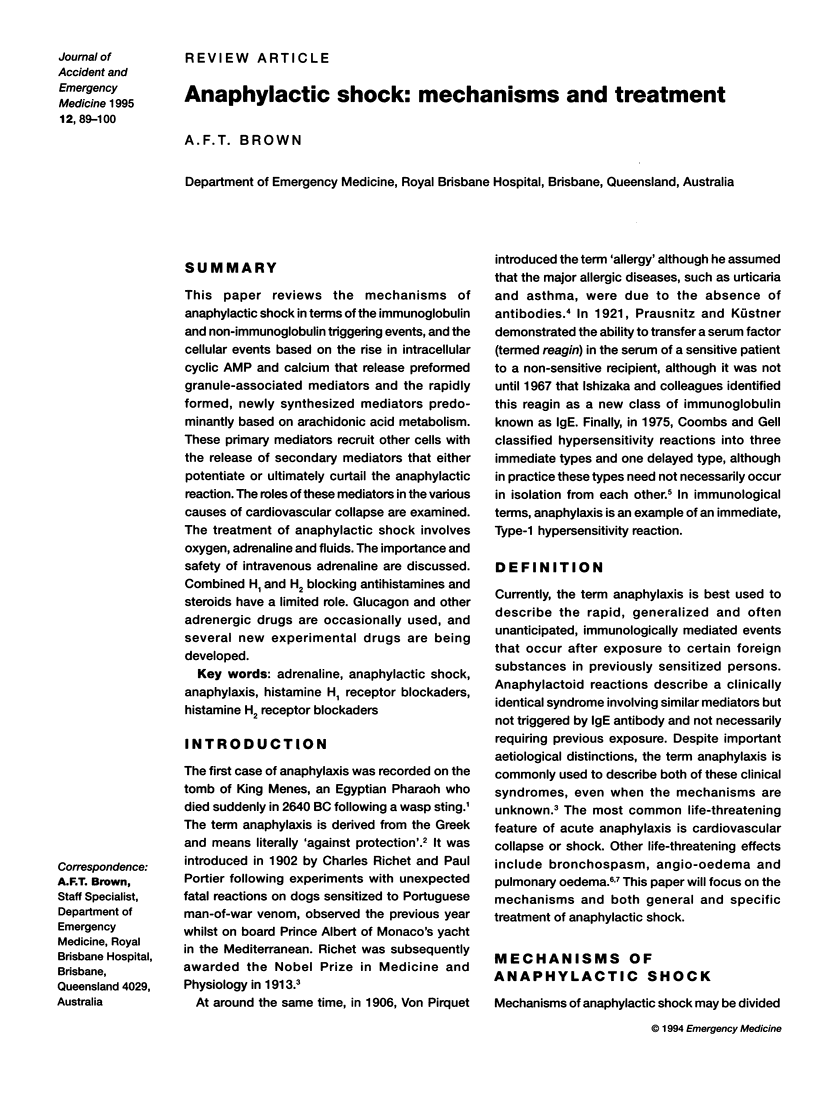
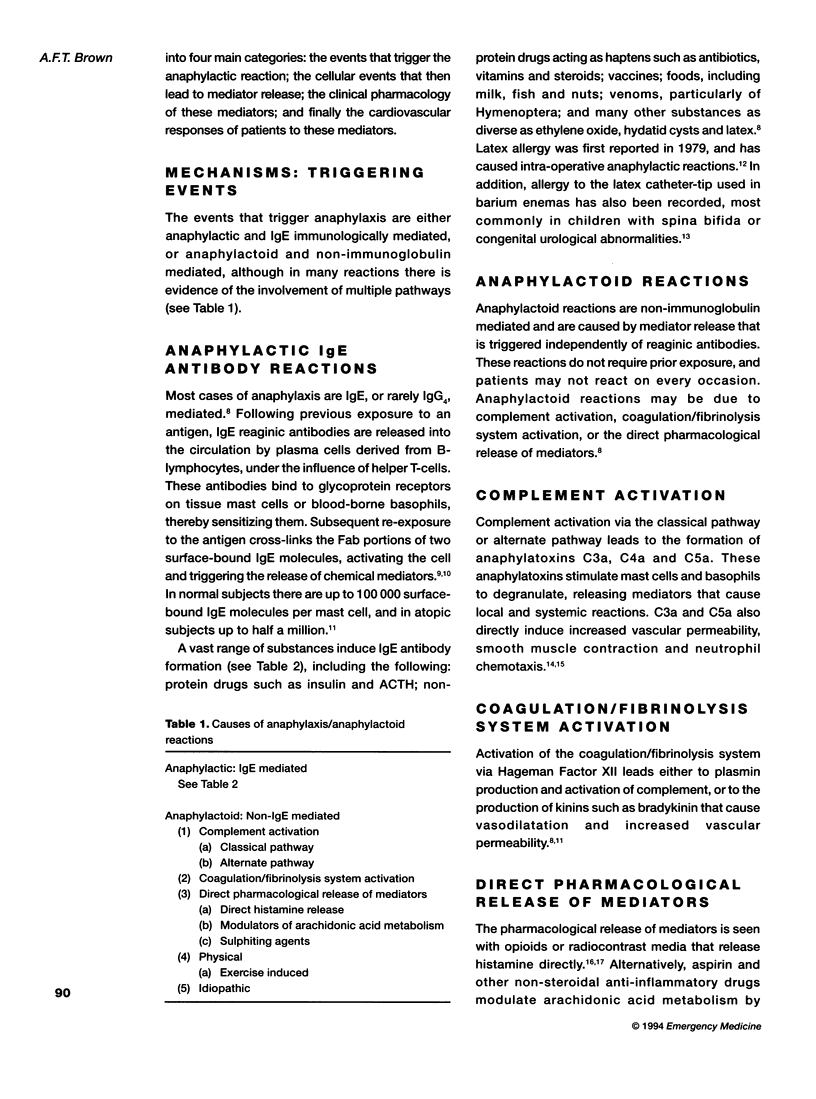
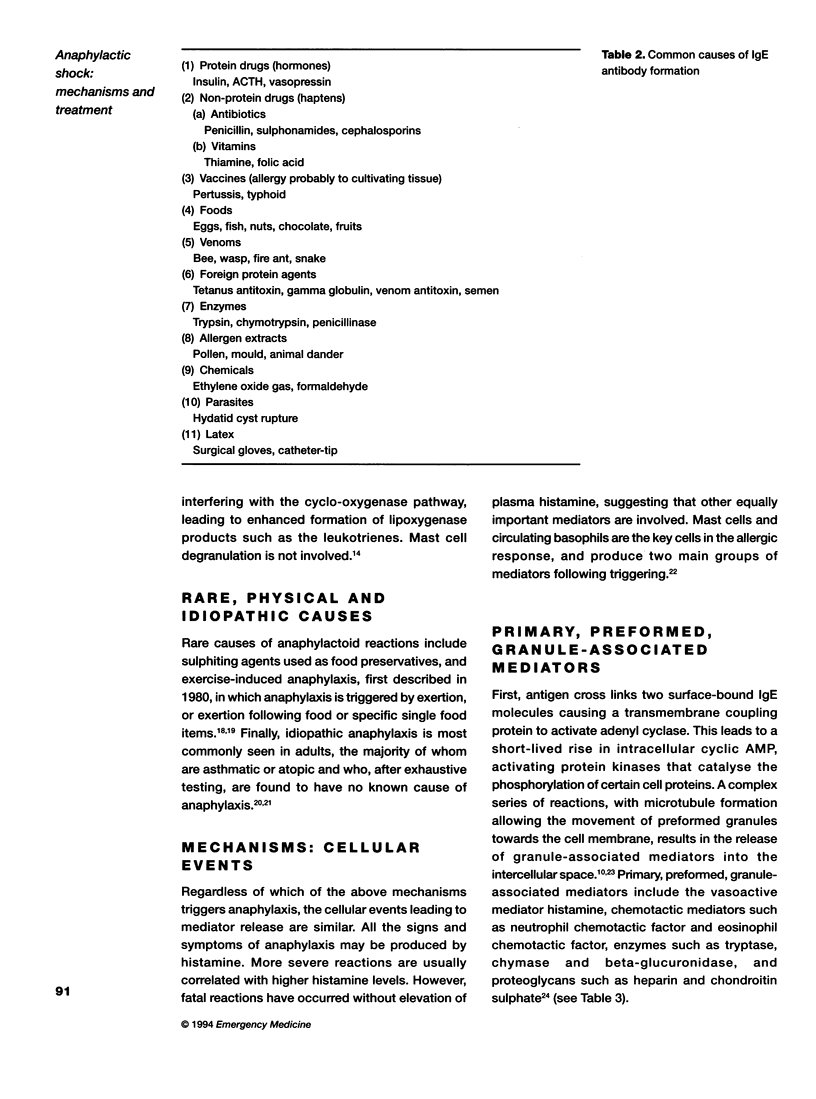
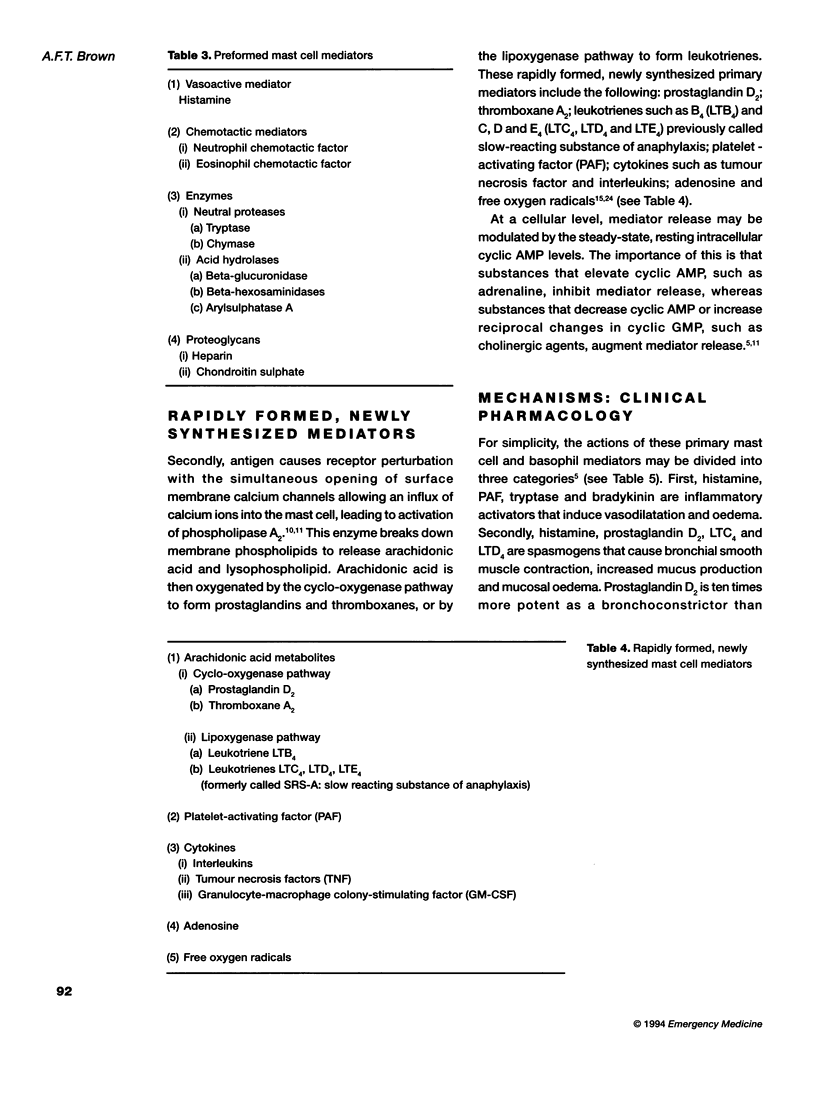
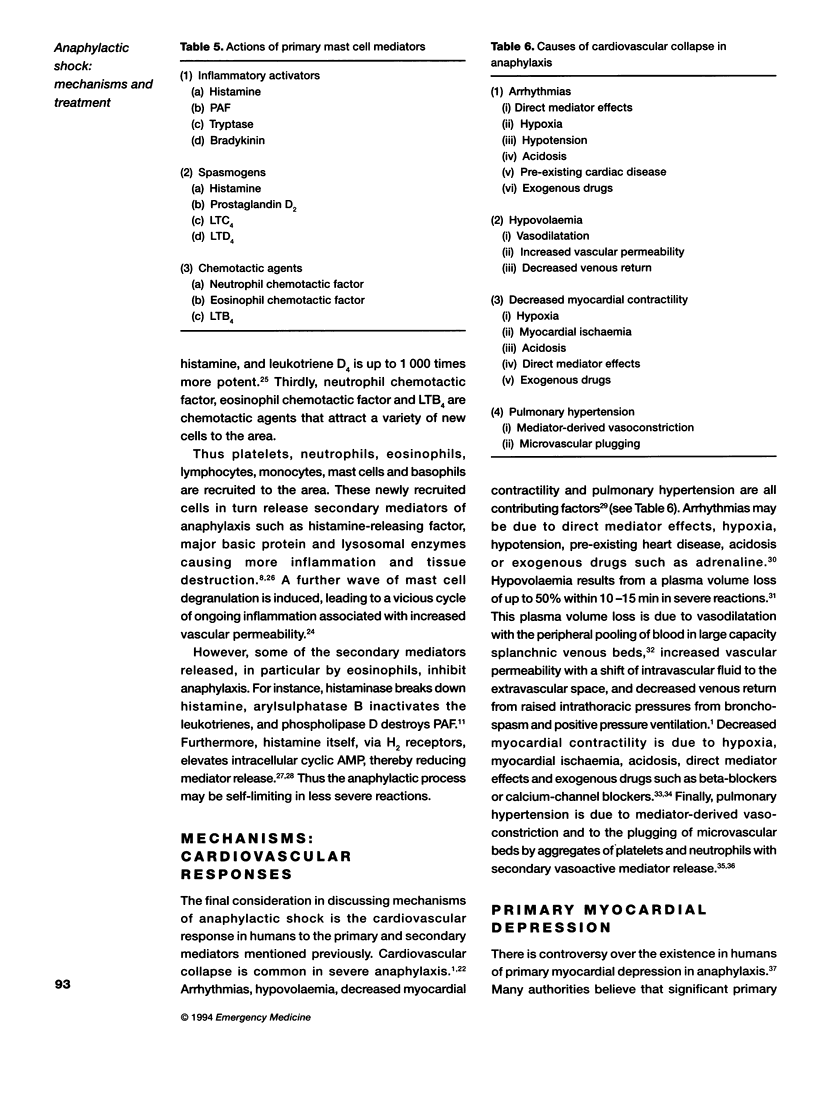
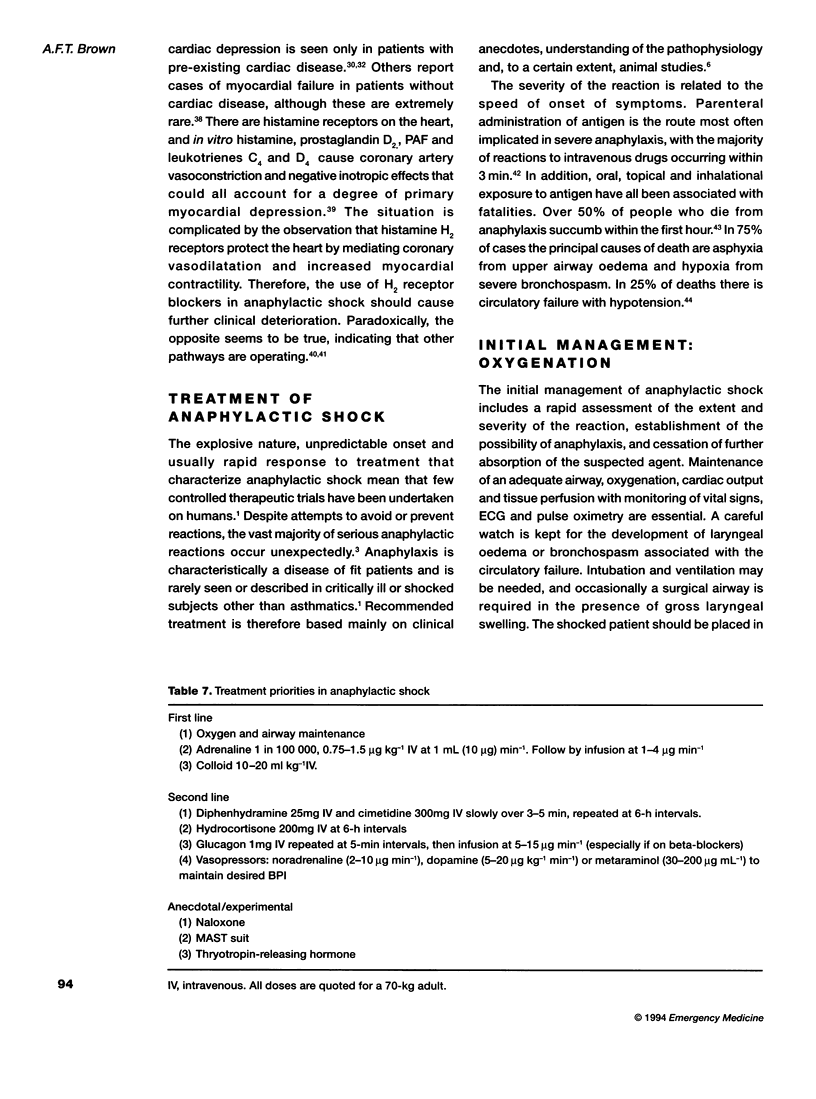
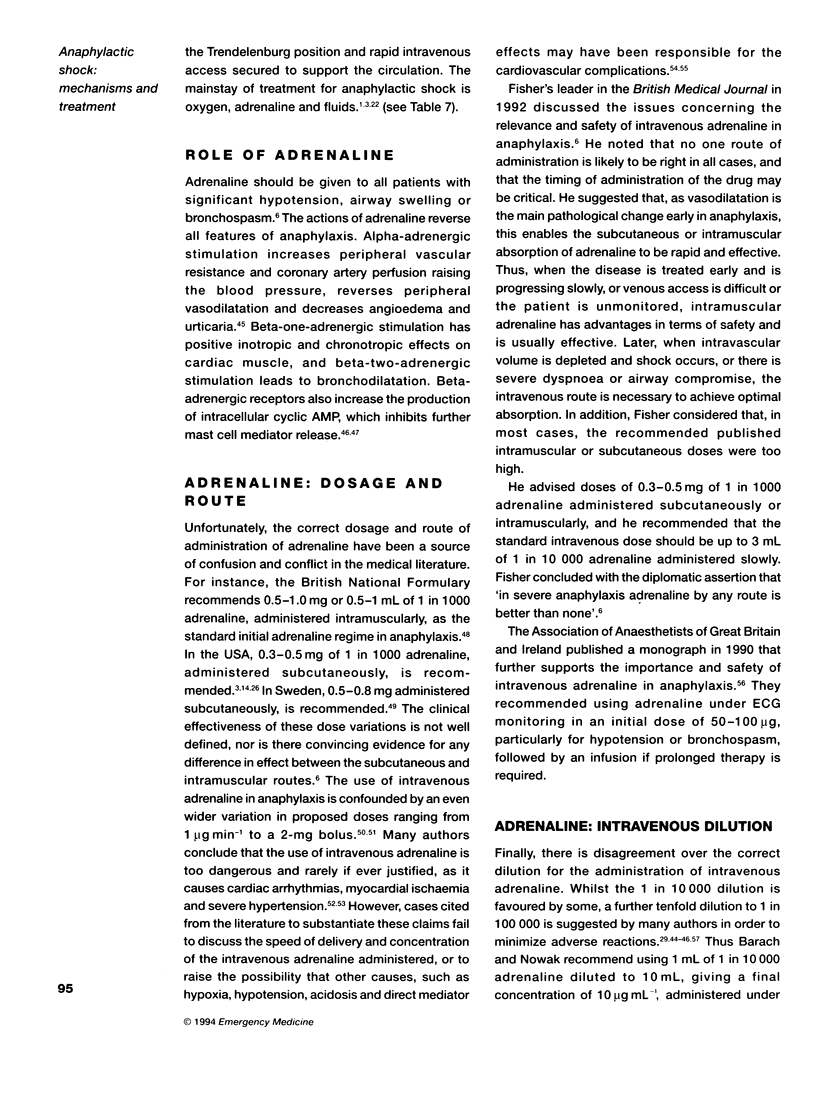
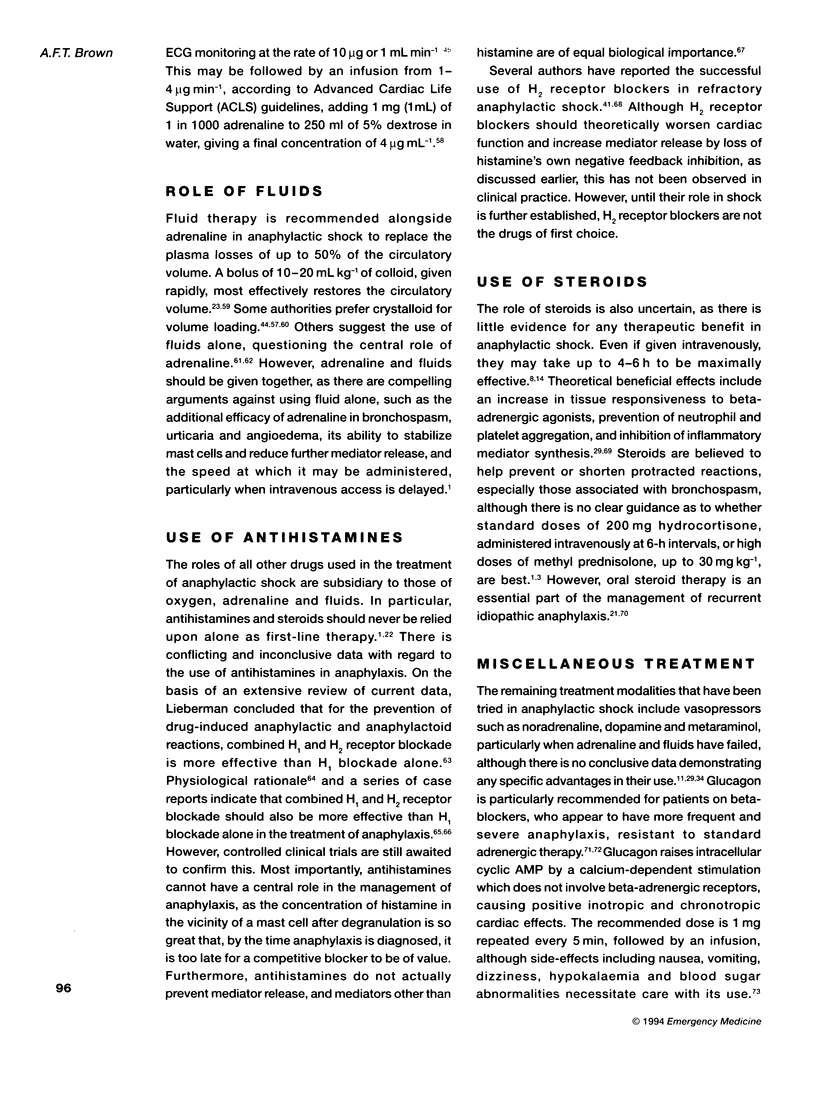
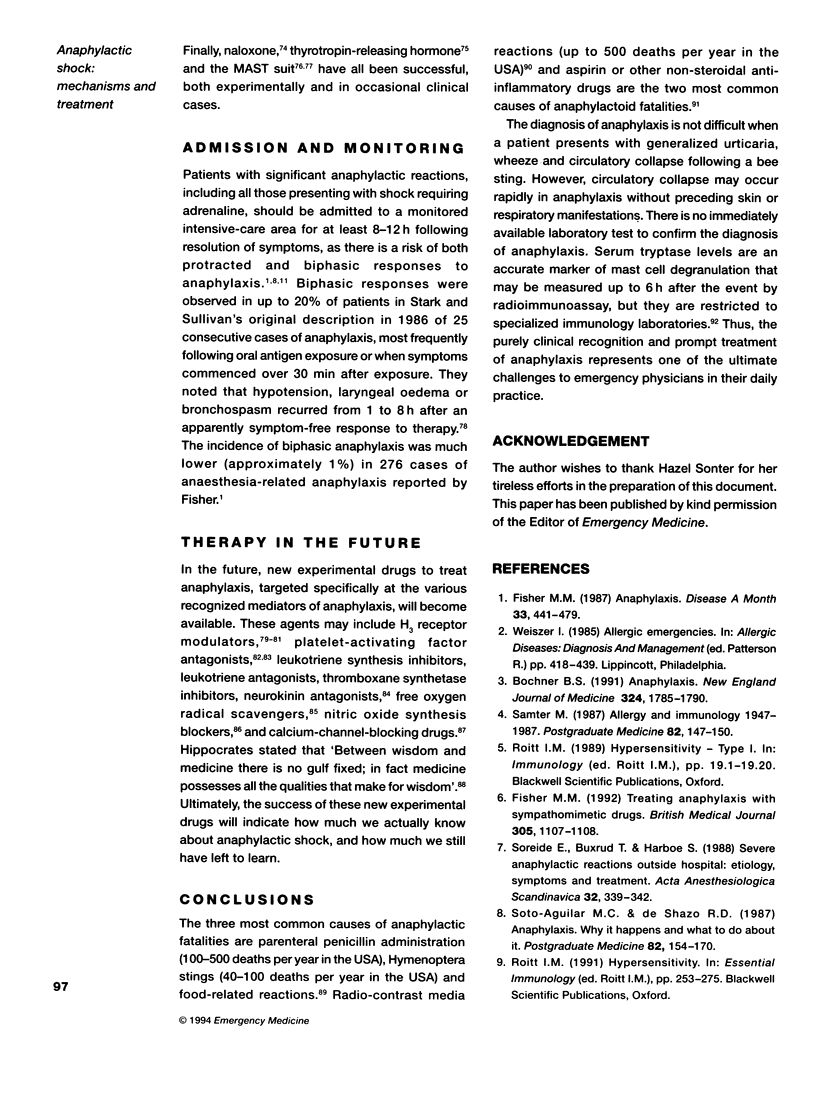
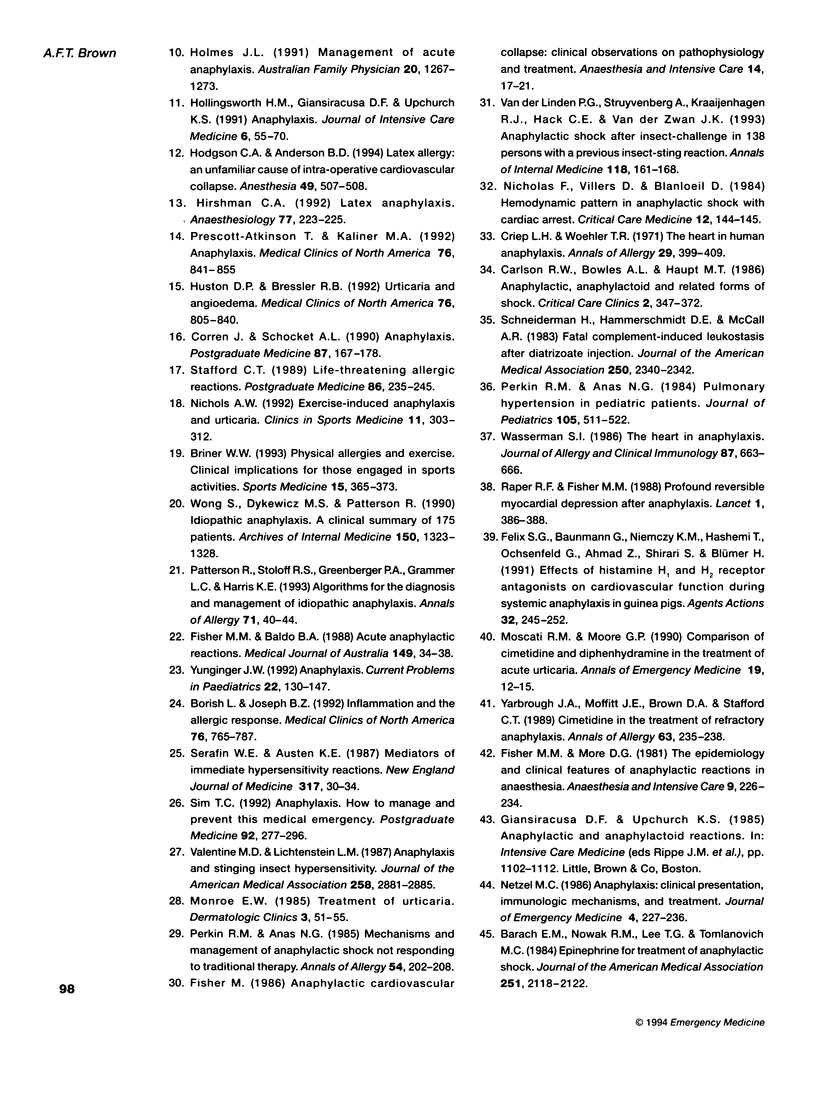
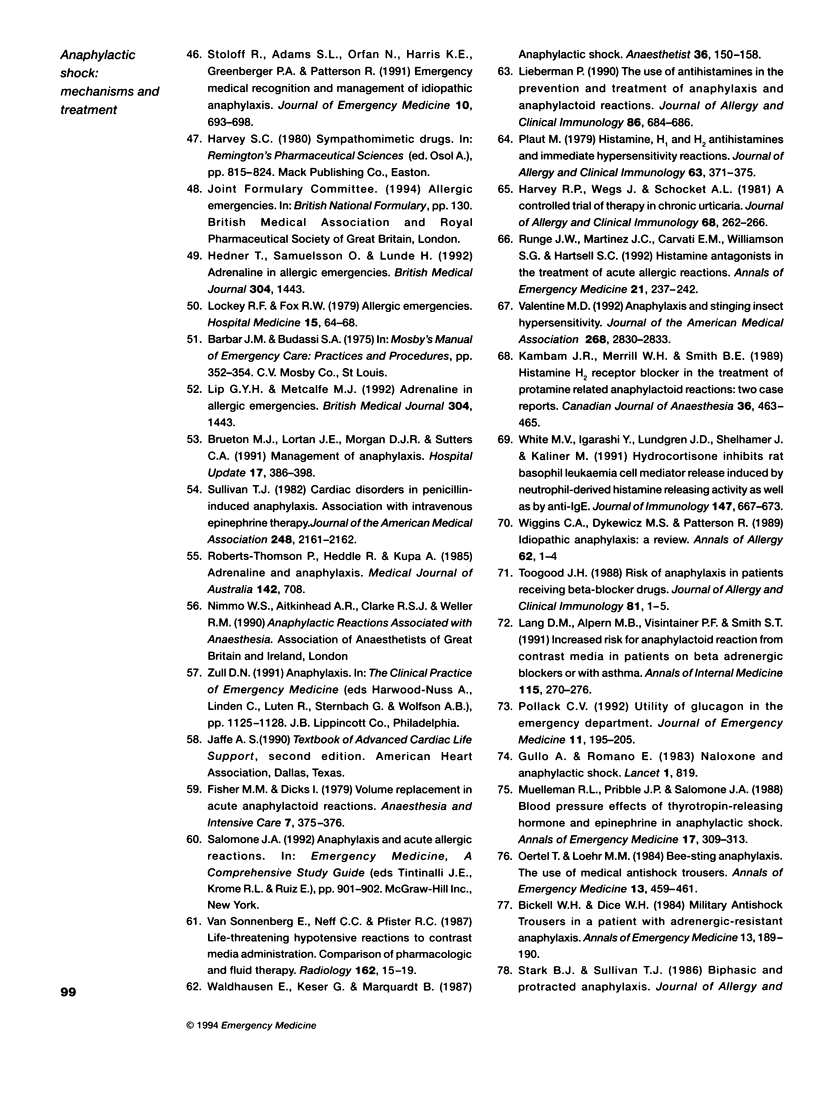
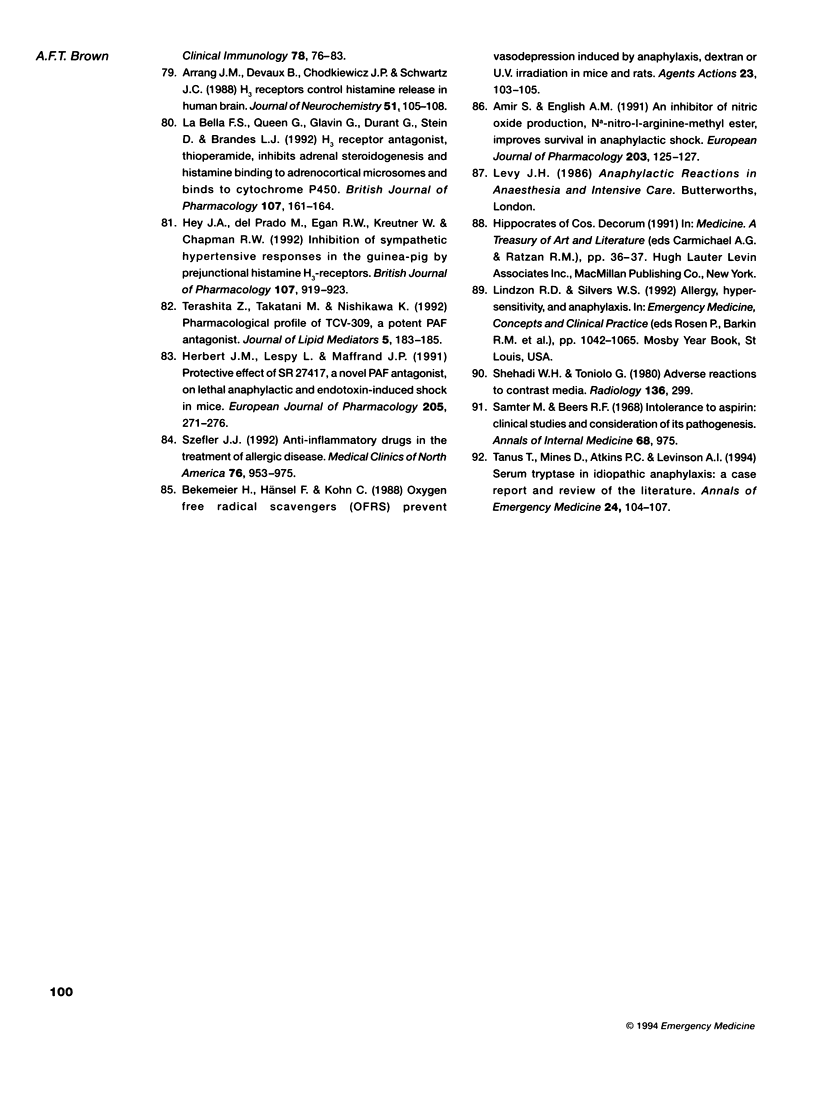
Selected References
These references are in PubMed. This may not be the complete list of references from this article.
- Amir S., English A. M. An inhibitor of nitric oxide production, NG-nitro-L-arginine-methyl ester, improves survival in anaphylactic shock. Eur J Pharmacol. 1991 Oct 2;203(1):125–127. doi: 10.1016/0014-2999(91)90800-6. [DOI] [PubMed] [Google Scholar]
- Arrang J. M., Devaux B., Chodkiewicz J. P., Schwartz J. C. H3-receptors control histamine release in human brain. J Neurochem. 1988 Jul;51(1):105–108. doi: 10.1111/j.1471-4159.1988.tb04841.x. [DOI] [PubMed] [Google Scholar]
- Atkinson T. P., Kaliner M. A. Anaphylaxis. Med Clin North Am. 1992 Jul;76(4):841–855. doi: 10.1016/s0025-7125(16)30328-5. [DOI] [PubMed] [Google Scholar]
- Bekemeier H., Hänsel F., Kuhn C. Oxygen free radical scavengers (OFRS) prevent vasodepression induced by anaphylaxis, dextran or u.v.-irradiation in mice and rats. Agents Actions. 1988 Feb;23(1-2):103–105. doi: 10.1007/BF01967205. [DOI] [PubMed] [Google Scholar]
- Bickell W. H., Dice W. H. Military antishock trousers in a patient with adrenergic-resistant anaphylaxis. Ann Emerg Med. 1984 Mar;13(3):189–190. doi: 10.1016/s0196-0644(84)80611-3. [DOI] [PubMed] [Google Scholar]
- Borish L., Joseph B. Z. Inflammation and the allergic response. Med Clin North Am. 1992 Jul;76(4):765–787. doi: 10.1016/s0025-7125(16)30325-x. [DOI] [PubMed] [Google Scholar]
- Briner W. W., Jr Physical allergies and exercise. Clinical implications for those engaged in sports activities. Sports Med. 1993 Jun;15(6):365–373. doi: 10.2165/00007256-199315060-00002. [DOI] [PubMed] [Google Scholar]
- Carlson R. W., Bowles A. L., Haupt M. T. Anaphylactic, anaphylactoid, and related forms of shock. Crit Care Clin. 1986 Apr;2(2):347–372. [PubMed] [Google Scholar]
- Clapham J., Kilpatrick G. J. Histamine H3 receptors modulate the release of [3H]-acetylcholine from slices of rat entorhinal cortex: evidence for the possible existence of H3 receptor subtypes. Br J Pharmacol. 1992 Dec;107(4):919–923. doi: 10.1111/j.1476-5381.1992.tb13386.x. [DOI] [PMC free article] [PubMed] [Google Scholar]
- Corren J., Schocket A. L. Anaphylaxis. A preventable emergency. Postgrad Med. 1990 Apr;87(5):167-8, 171-8. doi: 10.1080/00325481.1990.11704635. [DOI] [PubMed] [Google Scholar]
- Criep L. H., Woehler T. R. The heart in human anaphylaxis. Ann Allergy. 1971 Aug;29(8):399–409. [PubMed] [Google Scholar]
- Felix S. B., Baumann G., Niemczyk M., Hashemi T., Ochsenfeld G., Ahmad Z., Shirani S., Blömer H. Effects of histamine H1- and H2-receptor antagonists on cardiovascular function during systemic anaphylaxis in guinea pigs. Agents Actions. 1991 Mar;32(3-4):245–252. doi: 10.1007/BF01980881. [DOI] [PubMed] [Google Scholar]
- Fisher M. M., Baldo B. A. Acute anaphylactic reactions. Med J Aust. 1988 Jul 4;149(1):34–38. doi: 10.5694/j.1326-5377.1988.tb120481.x. [DOI] [PubMed] [Google Scholar]
- Fisher M. M. Clinical observations on the pathophysiology and treatment of anaphylactic cardiovascular collapse. Anaesth Intensive Care. 1986 Feb;14(1):17–21. doi: 10.1177/0310057X8601400105. [DOI] [PubMed] [Google Scholar]
- Fisher M. M., Dicks I. Volume replacement in acute anaphylactoid reactions. Anaesth Intensive Care. 1979 Nov;7(4):375–376. doi: 10.1177/0310057X7900700413. [DOI] [PubMed] [Google Scholar]
- Fisher M. M., More D. G. The epidemiology and clinical features of anaphylactic reactions in anaesthesia. Anaesth Intensive Care. 1981 Aug;9(3):226–234. doi: 10.1177/0310057X8100900304. [DOI] [PubMed] [Google Scholar]
- Fisher M. Anaphylaxis. Dis Mon. 1987 Aug;33(8):433–479. doi: 10.1016/0011-5029(87)90019-8. [DOI] [PubMed] [Google Scholar]
- Fisher M. Treating anaphylaxis with sympathomimetic drugs. BMJ. 1992 Nov 7;305(6862):1107–1108. doi: 10.1136/bmj.305.6862.1107. [DOI] [PMC free article] [PubMed] [Google Scholar]
- Gullo A., Romano E. Naloxone and anaphylactic shock. Lancet. 1983 Apr 9;1(8328):819–819. doi: 10.1016/s0140-6736(83)91873-1. [DOI] [PubMed] [Google Scholar]
- Harvey R. P., Wegs J., Schocket A. L. A controlled trial of therapy in chronic urticaria. J Allergy Clin Immunol. 1981 Oct;68(4):262–266. doi: 10.1016/0091-6749(81)90149-4. [DOI] [PubMed] [Google Scholar]
- Herbert J. M., Lespy L., Maffrand J. P. Protective effect of SR 27417, a novel PAF antagonist, on lethal anaphylactic and endotoxin-induced shock in mice. Eur J Pharmacol. 1991 Dec 3;205(3):271–276. doi: 10.1016/0014-2999(91)90909-a. [DOI] [PubMed] [Google Scholar]
- Hirshman C. A. Latex anaphylaxis. Anesthesiology. 1992 Aug;77(2):223–225. [PubMed] [Google Scholar]
- Hodgson C. A., Andersen B. D. Latex allergy: an unfamiliar cause of intra-operative cardiovascular collapse. Anaesthesia. 1994 Jun;49(6):507–508. doi: 10.1111/j.1365-2044.1994.tb03522.x. [DOI] [PubMed] [Google Scholar]
- Holmes J. L. Management of acute anaphylaxis. Aust Fam Physician. 1991 Sep;20(9):1267-9, 1272-3. [PubMed] [Google Scholar]
- Huston D. P., Bressler R. B. Urticaria and angioedema. Med Clin North Am. 1992 Jul;76(4):805–840. doi: 10.1016/s0025-7125(16)30327-3. [DOI] [PubMed] [Google Scholar]
- Kambam J. R., Merrill W. H., Smith B. E. Histamine 2 receptor blocker in the treatment of protamine related anaphylactoid reactions: two case reports. Can J Anaesth. 1989 Jul;36(4):463–465. doi: 10.1007/BF03005349. [DOI] [PubMed] [Google Scholar]
- LaBella F. S., Queen G., Glavin G., Durant G., Stein D., Brandes L. J. H3 receptor antagonist, thioperamide, inhibits adrenal steroidogenesis and histamine binding to adrenocortical microsomes and binds to cytochrome P450. Br J Pharmacol. 1992 Sep;107(1):161–164. doi: 10.1111/j.1476-5381.1992.tb14480.x. [DOI] [PMC free article] [PubMed] [Google Scholar]
- Lang D. M., Alpern M. B., Visintainer P. F., Smith S. T. Increased risk for anaphylactoid reaction from contrast media in patients on beta-adrenergic blockers or with asthma. Ann Intern Med. 1991 Aug 15;115(4):270–276. doi: 10.7326/0003-4819-115-4-270. [DOI] [PubMed] [Google Scholar]
- Lieberman P. The use of antihistamines in the prevention and treatment of anaphylaxis and anaphylactoid reactions. J Allergy Clin Immunol. 1990 Oct;86(4 Pt 2):684–686. doi: 10.1016/s0091-6749(05)80241-6. [DOI] [PubMed] [Google Scholar]
- Lip G. Y., Metcalfe M. J. Adrenaline in allergic emergencies. BMJ. 1992 May 30;304(6839):1443–1443. doi: 10.1136/bmj.304.6839.1443-a. [DOI] [PMC free article] [PubMed] [Google Scholar]
- Monroe E. W. Treatment of urticaria. Dermatol Clin. 1985 Jan;3(1):51–55. [PubMed] [Google Scholar]
- Moscati R. M., Moore G. P. Comparison of cimetidine and diphenhydramine in the treatment of acute urticaria. Ann Emerg Med. 1990 Jan;19(1):12–15. doi: 10.1016/s0196-0644(05)82131-6. [DOI] [PubMed] [Google Scholar]
- Muelleman R. L., Pribble J. P., Salomone J. A., 3rd Blood pressure effects of thyrotropin-releasing hormone and epinephrine in anaphylactic shock. Ann Emerg Med. 1988 Apr;17(4):309–313. doi: 10.1016/s0196-0644(88)80768-6. [DOI] [PubMed] [Google Scholar]
- Netzel M. C. Anaphylaxis: clinical presentation, immunologic mechanisms, and treatment. J Emerg Med. 1986;4(3):227–236. doi: 10.1016/0736-4679(86)90046-6. [DOI] [PubMed] [Google Scholar]
- Nichols A. W. Exercise-induced anaphylaxis and urticaria. Clin Sports Med. 1992 Apr;11(2):303–312. [PubMed] [Google Scholar]
- Nicolas F., Villers D., Blanloeil Y. Hemodynamic pattern in anaphylactic shock with cardiac arrest. Crit Care Med. 1984 Feb;12(2):144–145. doi: 10.1097/00003246-198402000-00013. [DOI] [PubMed] [Google Scholar]
- Oertel T., Loehr M. M. Bee-sting anaphylaxis: the use of medical antishock trousers. Ann Emerg Med. 1984 Jun;13(6):459–461. doi: 10.1016/s0196-0644(84)80011-6. [DOI] [PubMed] [Google Scholar]
- Patterson R., Stoloff R. S., Greenberger P. A., Grammer L. C., Harris K. E. Algorithms for the diagnosis and management of idiopathic anaphylaxis. Ann Allergy. 1993 Jul;71(1):40–44. [PubMed] [Google Scholar]
- Perkin R. M., Anas N. G. Mechanisms and management of anaphylactic shock not responding to traditional therapy. Ann Allergy. 1985 Mar;54(3):202–208. [PubMed] [Google Scholar]
- Perkin R. M., Anas N. G. Pulmonary hypertension in pediatric patients. J Pediatr. 1984 Oct;105(4):511–522. doi: 10.1016/s0022-3476(84)80413-8. [DOI] [PubMed] [Google Scholar]
- Plaut M. Histamine, H1 and H2 antihistamines, and immediate hypersensitivity reactions. J Allergy Clin Immunol. 1979 Jun;63(6):371–375. doi: 10.1016/0091-6749(79)90208-2. [DOI] [PubMed] [Google Scholar]
- Pollack C. V., Jr Utility of glucagon in the emergency department. J Emerg Med. 1993 Mar-Apr;11(2):195–205. doi: 10.1016/0736-4679(93)90519-d. [DOI] [PubMed] [Google Scholar]
- Raper R. F., Fisher M. M. Profound reversible myocardial depression after anaphylaxis. Lancet. 1988 Feb 20;1(8582):386–388. doi: 10.1016/s0140-6736(88)91184-1. [DOI] [PubMed] [Google Scholar]
- Roberts-Thomson P., Heddle R., Kupa A. Adrenaline and anaphylaxis. Med J Aust. 1985 Jun 24;142(13):708–708. [PubMed] [Google Scholar]
- Runge J. W., Martinez J. C., Caravati E. M., Williamson S. G., Hartsell S. C. Histamine antagonists in the treatment of acute allergic reactions. Ann Emerg Med. 1992 Mar;21(3):237–242. doi: 10.1016/s0196-0644(05)80881-9. [DOI] [PubMed] [Google Scholar]
- Samter M. Allergy and immunology 1947-1987. A PGM retrospective. Postgrad Med. 1987 Oct;82(5):147–150. doi: 10.1080/00325481.1987.11700003. [DOI] [PubMed] [Google Scholar]
- Samter M., Beers R. F., Jr Intolerance to aspirin. Clinical studies and consideration of its pathogenesis. Ann Intern Med. 1968 May;68(5):975–983. doi: 10.7326/0003-4819-68-5-975. [DOI] [PubMed] [Google Scholar]
- Schneiderman H., Hammerschmidt D. E., McCall A. R., Jacob H. S. Fatal complement-induced leukostasis after diatrizoate injection. Principles of clinicopathologic diagnosis. JAMA. 1983 Nov 4;250(17):2340–2342. [PubMed] [Google Scholar]
- Serafin W. E., Austen K. F. Mediators of immediate hypersensitivity reactions. N Engl J Med. 1987 Jul 2;317(1):30–34. doi: 10.1056/NEJM198707023170106. [DOI] [PubMed] [Google Scholar]
- Shehadi W. H., Toniolo G. Adverse reactions to contrast media: a report from the Committee on Safety of Contrast Media of the International Society of Radiology. Radiology. 1980 Nov;137(2):299–302. doi: 10.1148/radiology.137.2.7433658. [DOI] [PubMed] [Google Scholar]
- Sim T. C. Anaphylaxis. How to manage and prevent this medical emergency. Postgrad Med. 1992 Oct;92(5):277-84, 289, 292-6. doi: 10.1080/00325481.1992.11701498. [DOI] [PubMed] [Google Scholar]
- Soto-Aguilar M. C., deShazo R. D., Waring N. P. Anaphylaxis. Why it happens and what to do about it. Postgrad Med. 1987 Oct;82(5):154-60, 162-4, 167-70. doi: 10.1080/00325481.1987.11700005. [DOI] [PubMed] [Google Scholar]
- Stafford C. T. Life-threatening allergic reactions. Anticipating and preparing are the best defenses. Postgrad Med. 1989 Jul;86(1):235-42, 245. doi: 10.1080/00325481.1989.11704340. [DOI] [PubMed] [Google Scholar]
- Stark B. J., Sullivan T. J. Biphasic and protracted anaphylaxis. J Allergy Clin Immunol. 1986 Jul;78(1 Pt 1):76–83. doi: 10.1016/0091-6749(86)90117-x. [DOI] [PubMed] [Google Scholar]
- Stoloff R., Adams S. L., Orfan N., Harris K. E., Greenberger P. A., Patterson R. Emergency medical recognition and management of idiopathic anaphylaxis. J Emerg Med. 1992 Nov-Dec;10(6):693–698. doi: 10.1016/0736-4679(92)90527-z. [DOI] [PubMed] [Google Scholar]
- Sullivan T. J. Cardiac disorders in penicillin-induced anaphylaxis. Association with intravenous epinephrine therapy. JAMA. 1982 Nov 5;248(17):2161–2162. [PubMed] [Google Scholar]
- Szefler S. J. Anti-inflammatory drugs in the treatment of allergic disease. Med Clin North Am. 1992 Jul;76(4):953–975. doi: 10.1016/s0025-7125(16)30334-0. [DOI] [PubMed] [Google Scholar]
- Søreide E., Buxrud T., Harboe S. Severe anaphylactic reactions outside hospital: etiology, symptoms and treatment. Acta Anaesthesiol Scand. 1988 May;32(4):339–342. doi: 10.1111/j.1399-6576.1988.tb02740.x. [DOI] [PubMed] [Google Scholar]
- Tanus T., Mines D., Atkins P. C., Levinson A. I. Serum tryptase in idiopathic anaphylaxis: a case report and review of the literature. Ann Emerg Med. 1994 Jul;24(1):104–107. doi: 10.1016/s0196-0644(94)70169-5. [DOI] [PubMed] [Google Scholar]
- Terashita Z., Takatani M., Nishikawa K. Pharmacological profile of TCV-309--a potent PAF antagonist. J Lipid Mediat. 1992 Jun-Jul;5(2):183–185. [PubMed] [Google Scholar]
- Toogood J. H. Risk of anaphylaxis in patients receiving beta-blocker drugs. J Allergy Clin Immunol. 1988 Jan;81(1):1–5. doi: 10.1016/0091-6749(88)90212-6. [DOI] [PubMed] [Google Scholar]
- Valentine M. D. Anaphylaxis and stinging insect hypersensitivity. JAMA. 1992 Nov 25;268(20):2830–2833. [PubMed] [Google Scholar]
- Valentine M. D., Lichtenstein L. M. Anaphylaxis and stinging insect hypersensitivity. JAMA. 1987 Nov 27;258(20):2881–2885. [PubMed] [Google Scholar]
- Waldhausen E., Keser G., Marquardt B. Der anaphylaktische Schock. Anaesthesist. 1987 Apr;36(4):150–158. [PubMed] [Google Scholar]
- Wasserman S. I. The heart in anaphylaxis. J Allergy Clin Immunol. 1986 May;77(5):663–666. doi: 10.1016/0091-6749(86)90405-7. [DOI] [PubMed] [Google Scholar]
- White M. V., Igarashi Y., Lundgren J. D., Shelhamer J., Kaliner M. Hydrocortisone inhibits rat basophilic leukemia cell mediator release induced by neutrophil-derived histamine releasing activity as well as by anti-IgE. J Immunol. 1991 Jul 15;147(2):667–673. [PubMed] [Google Scholar]
- Wong S., Dykewicz M. S., Patterson R. Idiopathic anaphylaxis. A clinical summary of 175 patients. Arch Intern Med. 1990 Jun;150(6):1323–1328. doi: 10.1001/archinte.150.6.1323. [DOI] [PubMed] [Google Scholar]
- Yarbrough J. A., Moffitt J. E., Brown D. A., Stafford C. T. Cimetidine in the treatment of refractory anaphylaxis. Ann Allergy. 1989 Sep;63(3):235–238. [PubMed] [Google Scholar]
- Yunginger J. W. Anaphylaxis. Curr Probl Pediatr. 1992 Mar;22(3):130–147. doi: 10.1016/0045-9380(92)90003-h. [DOI] [PubMed] [Google Scholar]
- van der Linden P. W., Struyvenberg A., Kraaijenhagen R. J., Hack C. E., van der Zwan J. K. Anaphylactic shock after insect-sting challenge in 138 persons with a previous insect-sting reaction. Ann Intern Med. 1993 Feb 1;118(3):161–168. doi: 10.7326/0003-4819-118-3-199302010-00001. [DOI] [PubMed] [Google Scholar]
- vanSonnenberg E., Neff C. C., Pfister R. C. Life-threatening hypotensive reactions to contrast media administration: comparison of pharmacologic and fluid therapy. Radiology. 1987 Jan;162(1 Pt 1):15–19. doi: 10.1148/radiology.162.1.3786753. [DOI] [PubMed] [Google Scholar]


